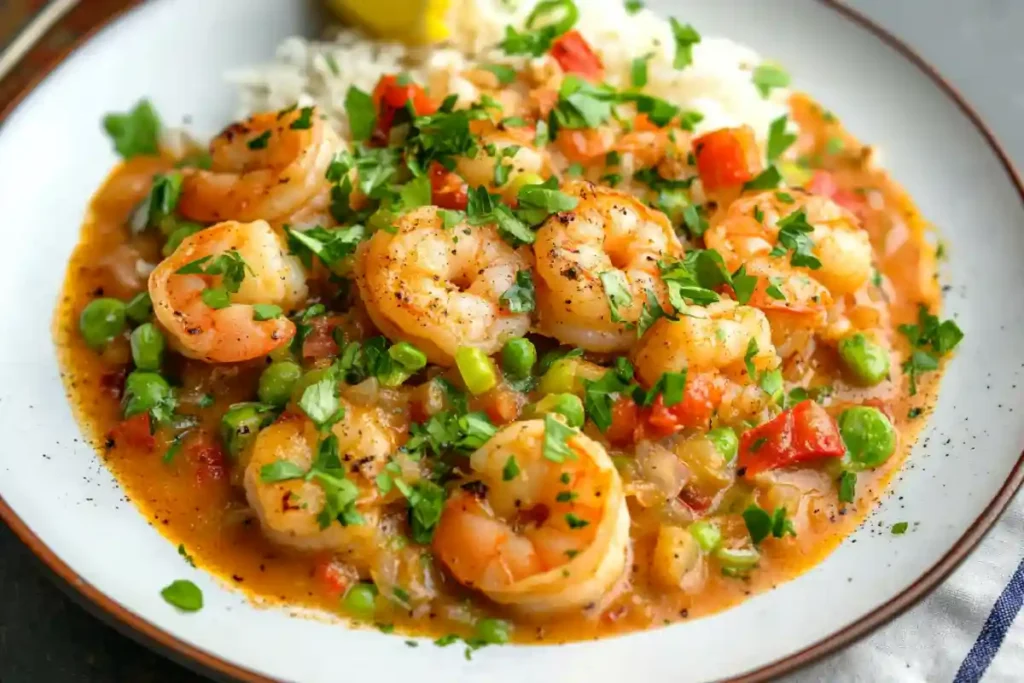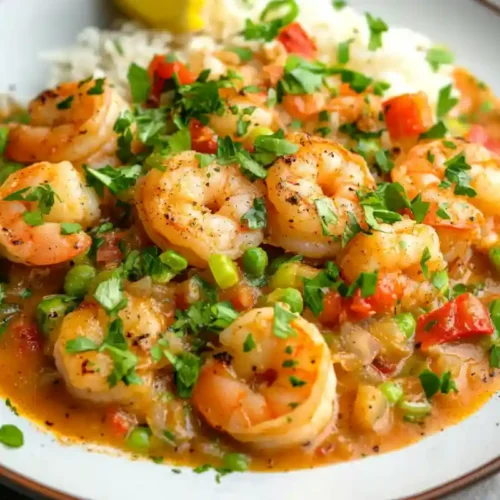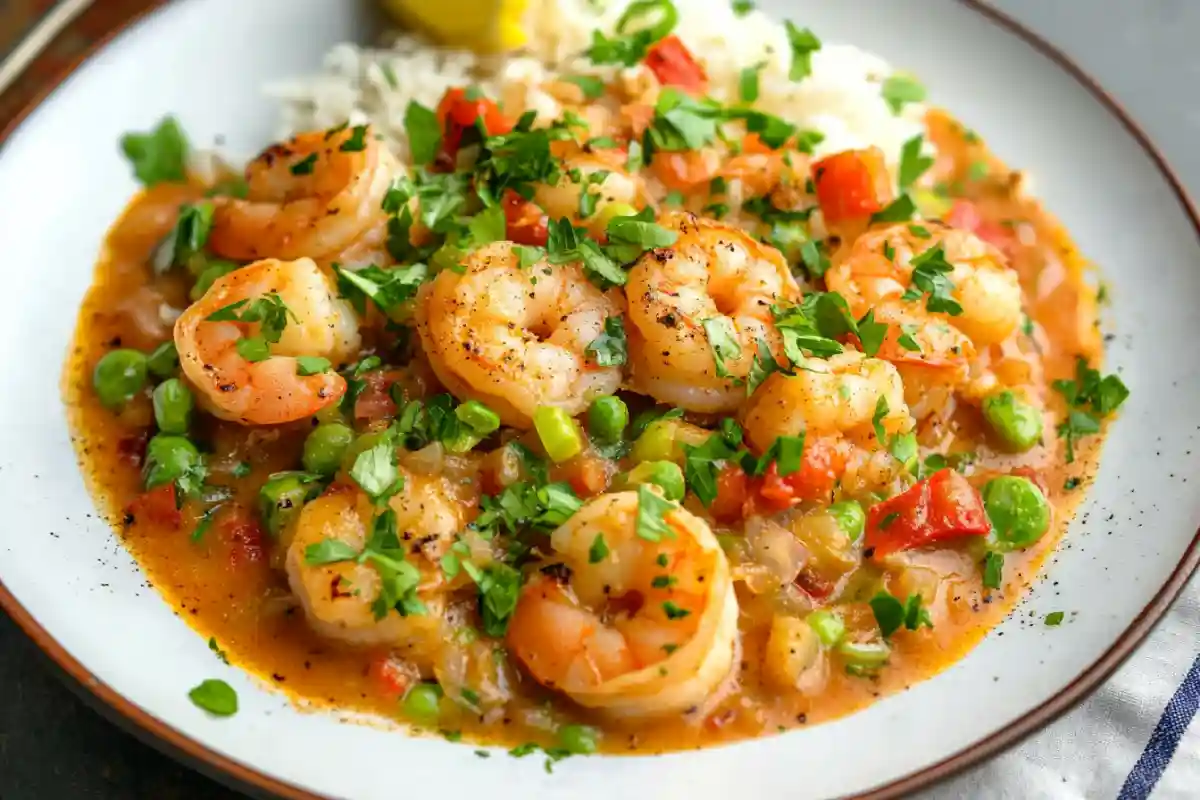
Table of Contents
This Cajun shrimp étouffée recipe builds a brick-red roux, smothers plump Gulf shrimp in peppery gravy, and hits the table in 35 minutes. After three skillet trials—tweaking roux depth and Cajun-seasoning heat—I locked in a 1-to-1 flour-to-fat ratio that stays silky without clumping and keeps every shrimp juicy, never rubbery.
What Is Etouffee? Understanding the Dish at Its Core
Before diving into the heart of the cajun shrimp etouffee recipe, it’s essential to understand the roots of this iconic dish. The word étouffée is French for “smothered,” which perfectly describes the method used to cook it. In essence, the ingredients are gently simmered in a richly flavored sauce, often thickened with a roux, until they become deeply infused with flavor.
At its foundation, etouffee is a bridge between French technique and Louisiana soul. Typically made with shellfish such as shrimp, crawfish, or crab, it showcases the bounty of the Gulf in the most comforting way possible. However, what makes this dish truly special is its ability to transform simple ingredients into something unforgettable.
The main ingredients of traditional etouffee recipes include:
- A light or medium roux (flour + fat)
- The “Holy Trinity” of Cajun cuisine: onion, celery, and bell pepper
- Garlic, bay leaves, and seasoning blends
- Stock made from shrimp or seafood shells
Some argue whether etouffee should include tomatoes. While Creole etouffee may use them, Cajun etouffee usually does not. This distinction highlights regional preferences and sparks passionate debates among Southern chefs. In fact, chefs like Justin Devillier have weighed in on the delicate balance of tradition and creativity in Cajun cuisine.
Moreover, if you’ve ever wondered how to make etouffee the authentic way, it all begins with understanding your roux. Mastering the roux’s depth and color is key to unlocking the rich, smoky taste that defines a great cajun shrimp etouffee recipe.
For those looking to build flavor from the ground up, consider using bold, homemade seasonings like those in this Cajun Seasoning for Gumbo recipe. It provides a vibrant, spice-forward base that complements the smoky undertones of the dish beautifully.
Ingredients in a Cajun Shrimp Etouffee Recipe
To bring a classic cajun shrimp etouffee recipe to life, you must begin with the right foundation. These ingredients are not only traditional—they’re carefully balanced to create that unmistakable Southern flavor. While it may seem complex at first, each element serves a purpose. And with the right prep, everything comes together smoothly.
Although every cook adds their personal touch, certain components are non-negotiable. The key is knowing how each one contributes to the overall flavor profile. For instance, your roux is just as critical as your shrimp. Likewise, the seasoning blend adds depth, while the Holy Trinity delivers bold, savory notes.
Here’s a breakdown of what you’ll need:
🧂 Core Ingredients Checklist
- Shrimp (peeled, deveined, preferably Gulf shrimp)
- Unsalted butter or oil
- All-purpose flour (for making the roux)
- Onion, celery, and green bell pepper
- Garlic (minced)
- Seafood stock or broth
- Bay leaves, thyme, paprika, and black pepper
- Cajun seasoning
- Salt and your favorite hot sauce (optional)
For readers interested in exploring other iconic Louisiana meals, take a look at these Louisiana dishes for broader inspiration and pairing ideas.
🧾 Ingredient Function Table
| Ingredient | Role in Dish |
|---|---|
| Shrimp | Adds sweetness and protein |
| Butter + Flour (Roux) | Creates the rich, thick base |
| Holy Trinity Veggies | Builds foundational flavor |
| Garlic | Adds warmth and pungency |
| Cajun Seasoning | Brings signature heat and spice |
| Bay Leaves + Thyme | Adds earthy, aromatic depth |
| Seafood Stock | Enhances umami and seafood profile |
| Hot Sauce | Optional kick for bold flavor lovers |
Each component enhances the others, creating harmony in every bite. Because of this balance, the cajun shrimp etouffee recipe stands as a signature of Southern cuisine—bold, rich, and comforting.
What Is Etouffee Roux? The Heart of the Cajun Shrimp Etouffee Recipe
While shrimp may take center stage, no cajun shrimp etouffee recipe would be complete without its flavorful foundation—the roux. This thickening agent does more than hold the dish together; it infuses it with deep, nutty, and toasty undertones that define the taste of true Louisiana cooking.
Roux is a mixture of fat and flour, slowly cooked to varying degrees of darkness depending on the desired flavor. It might sound simple, yet mastering it can make all the difference. Fortunately, when done correctly, this essential step becomes a straightforward process.
Here’s what you need to know:
🔥 Why Roux Matters in Etouffee
- Adds rich, nutty flavor
- Thickens the sauce into a silky consistency
- Creates the signature color and depth
🥄 Types of Roux and Their Roles
| Roux Color | Flavor Profile | Usage in Etouffee |
|---|---|---|
| Blonde Roux | Mild, slightly nutty | Lighter etouffee versions |
| Medium Brown Roux | Rich, toasty, full-bodied | Traditional cajun etouffee |
| Dark Roux | Smoky, bold, less thickening | More common in gumbo |
👩🍳 How to Make It (The Basics)
- Melt unsalted butter or heat oil in a pan
- Stir in all-purpose flour slowly
- Cook on medium-low heat, stirring constantly
- Wait until it turns the desired color—this can take 10–30 minutes
🔗 Want to learn how roux varies across Louisiana classics? Check out this helpful guide on Cajun Gumbo vs Creole Gumbo, which explains how different roux colors affect taste.
How to Make Shrimp Etouffee: A Step-by-Step Guide
Now that you understand the role of a good roux, it’s time to bring everything together. Fortunately, this part of the cajun shrimp etouffee recipe is both rewarding and surprisingly simple—especially if you follow each step with care. From preparing the shrimp to simmering your sauce, every move adds depth and flavor.
Let’s walk through the process from start to finish.
🔪 Step-by-Step Instructions
- Prepare the shrimp
- Peel and devein if needed
- Season lightly with Cajun spices
- Make the roux
- Combine flour and butter or oil over medium heat
- Stir constantly until it reaches a medium brown color
- Add vegetables and garlic
- Sauté onion, bell pepper, celery (Holy Trinity)
- Add garlic last to avoid burning
- Pour in the stock
- Add shrimp or seafood stock gradually
- Stir until the mixture becomes smooth and thickened
- Season the sauce
- Mix in paprika, thyme, Cajun seasoning, and bay leaves
- Add salt and black pepper to taste
- Add the shrimp
- Let them simmer gently for 5–7 minutes
- Avoid overcooking for best texture
- Serve over rice
- Spoon the etouffee generously over white rice
- Garnish with chopped green onions or parsley
📊 Etouffee Cooking Timeline (At a Glance)
| Stage | Time Needed | Key Tip |
|---|---|---|
| Shrimp Prep | 5 mins | Use Gulf shrimp if possible |
| Roux Cooking | 15 mins | Stir constantly to avoid burning |
| Veggie Sauté | 5–7 mins | Cook until soft and fragrant |
| Sauce Assembly | 10 mins | Add stock gradually to control thickness |
| Shrimp Simmering | 5–7 mins | Add at the end to keep them tender |
| Total Cook Time | ~40 mins | Allow time for flavors to develop |
Cajun vs. Creole Etouffee – What’s the Difference?
If you’ve explored Southern cuisine, you’ve likely noticed that etouffee isn’t always the same. That’s because it comes in two flavorful styles—Cajun and Creole. Both are beloved in Louisiana, yet each offers a unique twist. To master the cajun shrimp etouffee recipe, it’s essential to understand how these styles differ. Fortunately, once you learn the basics, the choice becomes easier—and tastier.
Let’s break it down clearly.
🌶️ Cajun Etouffee
Cajun cuisine comes from rural areas of Louisiana. It focuses on bold, rustic flavors built from simple ingredients.
- Uses a dark roux for rich flavor
- Typically no tomatoes
- Spicier, with pepper-forward seasoning
- Cooked in a single pot, often without extras
🍅 Creole Etouffee
Creole cuisine is rooted in the city of New Orleans. It blends French, Spanish, and African influences.
- Often includes tomatoes for a lighter, tangier sauce
- Slightly milder in spice
- Sometimes features butter or even cream
- Refined, often served in upscale settings
🆚 Cajun vs. Creole Etouffee: Quick Comparison
| Feature | Cajun Etouffee | Creole Etouffee |
|---|---|---|
| Roux Type | Dark roux | Blonde or medium roux |
| Tomatoes | Rarely used | Commonly included |
| Spice Level | Spicy, peppery | Mild to moderate |
| Flavor Profile | Smoky, earthy, bold | Bright, tangy, slightly sweet |
| Origin | Rural Louisiana (country) | New Orleans (city) |
Conclusion
By now, you’ve explored every flavorful detail of the cajun shrimp etouffee recipe—from its roots in Louisiana to the essential steps, ingredients, and regional variations. But more importantly, you now have everything you need to recreate this bold, comforting dish in your own kitchen.
Although it may seem like a complex recipe at first, the beauty of etouffee lies in its simplicity. By layering flavor gradually—from the roux to the seasoning—you create a dish that’s rich, soulful, and deeply satisfying. Even if you’re cooking it for the first time, each step is manageable, especially when you take your time and follow the rhythm of the process.
Let’s quickly recap why this dish is so rewarding to make:
- It’s deeply tied to Louisiana’s cultural and culinary history
- The ingredients are simple and flexible
- Every bite delivers smoky, savory flavor
- It can easily be adjusted to suit your spice preferences
- It goes wonderfully with a variety of side dishes.
Whether you’re cooking for your family or planning a special dinner, the cajun shrimp etouffee recipe is a surefire way to impress and satisfy. Once you’ve made it once, chances are you’ll find yourself making it again—and possibly adding your own personal twist.
So grab your skillet, stir that roux, and let the aromas of the bayou fill your home. After all, this isn’t just a recipe—it’s a tradition worth savoring.
Frequently Asked Questions (FAQs)
Even with a detailed walkthrough, it’s natural to have a few more questions before mastering your cajun shrimp etouffee recipe. To help you feel confident in the kitchen, we’ve answered some of the most common and important questions below. These insights can guide you whether you’re cooking for the first time or simply refining your approach.
What is the difference between shrimp creole and etouffee?
While both dishes are Louisiana staples, the key difference lies in the sauce. Shrimp creole uses a tomato-based sauce that’s more stew-like, whereas etouffee features a roux-based sauce that is thicker, richer, and often spicier. Etouffee is also typically “smothered,” which means it’s simmered longer and served over rice to absorb the flavorful gravy. Creole dishes lean a bit more toward a Mediterranean influence, while etouffee keeps its rustic Cajun roots.
What is etouffee sauce made of?
Etouffee sauce starts with a roux—usually butter and flour cooked until golden or medium brown. From there, it’s layered with the Holy Trinity (onion, celery, and bell pepper), garlic, Cajun spices, and seafood or chicken stock. This sauce thickens as it simmers, resulting in the silky, flavorful base you expect from a traditional cajun shrimp etouffee recipe.
What are the ingredients in shrimp etouffee?
A classic shrimp etouffee recipe includes:
Shrimp (peeled and deveined)
Butter or oil for the roux
Flour (for thickening)
Onion, celery, and bell pepper
Garlic and Cajun seasoning
Bay leaves, thyme, and stock
Hot sauce (optional for heat)What is the seasoning in Cajun etouffee?
Cajun seasoning typically blends paprika, cayenne pepper, garlic powder, onion powder, oregano, and thyme. It’s often homemade, although many store-bought versions work well too. This seasoning is what gives a cajun shrimp etouffee recipe its bold, smoky heat and Southern character. Adjusting the blend allows you to control the spice level to suit your taste.

Cajun Shrimp Etouffee Recipe
Ingredients
- 1 lb shrimp peeled and deveined medium to large
- 4 tbsp unsalted butter or vegetable oil for the roux
- 4 tbsp all-purpose flour
- 1 cup yellow onion finely chopped
- 1 cup green bell pepper finely chopped
- 1 cup celery finely chopped
- 3 cloves garlic minced
- 2 cups seafood stock or shrimp/chicken broth
- 1 tbsp Cajun seasoning adjust to taste
- ½ tsp thyme dried
- 2 bay leaves whole
- ½ tsp paprika smoked or sweet
- ½ tsp salt or to taste
- ¼ tsp black pepper or to taste
- 1 dash hot sauce optional
- 2 tbsp green onions chopped for garnish
- 4 cups cooked white rice for serving
Instructions
- Prepare the shrimp: Pat dry and season lightly with a pinch of Cajun seasoning. Set aside.
- Make the roux: In a large skillet or Dutch oven, melt butter over medium heat. Stir in flour and whisk continuously for 10–15 minutes until the roux is medium brown and fragrant.
- Add the vegetables: Stir in onion, bell pepper, and celery. Cook for 5–7 minutes until softened. Then, add garlic and sauté for 30 seconds more.
- Deglaze and build the sauce: Gradually whisk in seafood stock while stirring to avoid lumps. Bring to a gentle simmer.
- Season: Add Cajun seasoning, thyme, paprika, bay leaves, salt, and black pepper. Stir to combine.
- Simmer: Let the sauce simmer for 10–15 minutes, uncovered, until slightly thickened.
- Add the shrimp: Gently fold in the shrimp and simmer for 5–7 minutes, or until they turn pink and are just cooked through.
- Serve: Spoon over a bed of cooked white rice and garnish with green onions. Add hot sauce if desired.
Notes
- For a spicier kick, add cayenne pepper or use extra hot sauce.
- You can swap shrimp for crawfish or crab for a regional twist.
- Store leftovers in an airtight container for up to 3 days in the fridge.
- This recipe freezes well—just leave out the shrimp and add it fresh when reheating.
- To make it dairy-free, substitute butter with vegetable oil.

